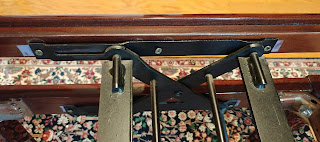- Add a 9V DC jack for adapter power.
- Add a power light adjacent to the input jack to remind the user to unplug the input cord.
- Add an "active" light next to the footswitch.
- Add a graphic label.
I ended up using Valvewizard's MOSFET source-follower variant of the Millenium Bypass circuit for the "active" light.
Since I was adding the 9V jack, I also added a reverse-polarity diode, though it wasn't necessary to protect the effect circuit: The 2N5457 JFETs that make up the circuit have interchangeable source and drain, so reversing the polarity just turns every common-source gain stage into a common-drain buffer stage and vice-versa. It won't actually work with power polarity reversed, but the JFETs won't be damaged. The power LED can be damaged by reverse polarity so there is some purpose there.
Here's the schematic as it stands. If you didn't read the original article, much of it was based on taking a typical tube amp approach, with component values adjusted for the lower voltages of a JFET circuit. A couple things were just outright mistakes, but I left them.
The graphic label (for the top surface only) was inkjet-printed onto vinyl label material, and features stylized versions of the original pictograms (☠💖🎶) for the knobs:
Aside from the mostly cosmetic and convenience changes, it's still the same guitar effect it was when I built it more than a decade ago:
- It's not quite like any other distortion device I have.
- It's still really noisy (mostly due to large-value resistors in the wrong places).
- There's still DC current through the "Skull" and "Quaver" potentiometers, so they "scratch" when adjusted.
It also turns out that the 9V jack is not too useful: Since it's all Class-A gain stages, the power supply noise from a switching-mode "wall wart" supply that makes its way into the audio signal is just too much for even practice use.
I'll probably update this post with an audio recording soon, since I had never bothered to include one with the original design.
Here's what the simulated output is, with 1 kHz sine input and increasing "Skull" values:












